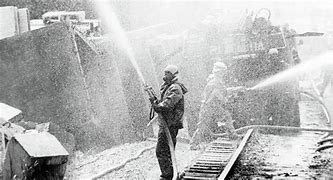Twenty years after the explosion, the cooled magma at the reactor's core 14 meters underground is still a terrible threat.
爆炸事故20年后,在14公尺地底下的反應(yīng)爐核心冷卻巖漿依然構(gòu)成恐怖威脅。
And will remains so for years to come.
其威脅將持續(xù)到未來。
I pray God the sarcophagus never collapses.
我向上帝祈禱,石棺永遠(yuǎn)不會坍塌。
That would be the worst thing that could happen.
這將是最恐怖的情況。
Because inside, there are 100kg of plutonium.
因為石棺內(nèi)有100公斤的鈽。
One microgram is the lethal dose for a human being.
只需百萬分之一公克的鈽,就足以致命。
That means there's enough plutonium to poison a hundred million people.
這表示里頭的鈽足以害死上億人。
The half-life of plutonium, in other words the time it takes for half of the plutonium to disappear, is 245,000 years.
鈽的半衰期,換句話說,要讓半數(shù)的鈽消失需要245000年的時間。

It's something we could thus consider eternal.
因此可以說,它的粒子將恒久存在。
There are areas where there will never be life again...
有些地區(qū)從此不會再出現(xiàn)生命......
Despite this terrible warning the nuclear disarmament sparked by Chernobyl is clearly coming into question today.
盡管有嚴(yán)重的警告,切爾諾貝利所啟發(fā)的裁軍行動在今天卻成為爭論話題。
If nuclear development for civilian uses is being put foryard as a solution to the problems of fossil fuels and global warming,
如果民用核子發(fā)展持續(xù)進行,以作為核融合與全球暖化現(xiàn)象的解決方案,這片大地提醒著我們,
this landscape reminds us that such an option is not without consequences.
這個選擇可能帶來的后果。
It requires the greatest caution...and clear information on the real risks it presents.
它需要極度謹(jǐn)慎,并需要明確告知所帶來的風(fēng)險。
Chernobyl also reminds us that if we must live with radioactivity and its unavoidable dangers
切爾諾貝利還提醒了我們,如果我們必須與放射性以及與它帶來的必然危險共存,
we also need to spare future generations from any risk of nuclear apocalypse.
我們還須設(shè)法讓后代免于核子災(zāi)變的陰影當(dāng)中。











